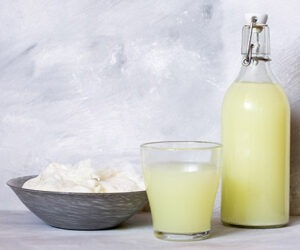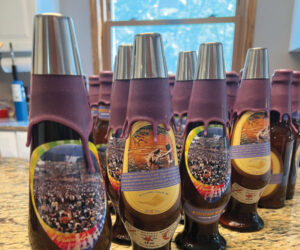Pirate Brews In Colorado
Driving down a dirt road surrounded by pine trees, we eventually reached the clearing. We were hundreds of miles from the ocean and there were no ships in sight, but 100 or so pirates and wenches were running errands about the half-acre of cleared land. The sound of music filled the air and pirate flags, fire pits, grills, and wedding decor made for a colorful vision. Greeted by a salty language foreign to us, we made our way to the beer dome.
This was all driven by the popularity of the Pirates of the Caribbean movie franchise, which ignited a bit of a pirate frenzy at the time. The happy couple at the center of this celebration were my daughter and her fiancé, who requested all guests dress in their best pirate garb and come to party like it was 1699. They also asked me to brew some special suds for the occasion.
I was given the freedom to brew what I wanted, and I knew it needed to be something special, even unique, something that fit the Caribbean pirate theme. In browsing at a local discount market, I came across a bag of coconut palm sugar. I had read this was a great brewing ingredient and decided this would be the direction I would go. OK, palm trees and coconuts, what else screams Caribbean? How about pineapple, jerk spices, and Scotch bonnet peppers? Now we are getting somewhere! I also thought about rum, but maybe that would be going too far.
I then had a second idea, the ghost ship in the movies was called The Black Pearl. Pearls come from oysters, and I had never brewed an oyster stout. Now was the time. So, I decided to brew two stouts. The first I called Jamaican Stout and the second Black Pearl Oyster Stout (see below). Avast! Ye Scurvy Dog! Get on to the brews!
Jamaican Stout
This stout used coconut palm sugar, pineapple juice, coconut juice, jerk spices, and a habanero pepper for a definite Caribbean feel. This was simply a lovely, silky, complex brew. Nicely conditioned with a creamy tan head on a dark brown body. A tantalizing subtle fruitiness, a hint of pungent earthiness from the Jerk spices and coconut, and just a touch of heat at the back of the palate.
Black Pearl Oyster Stout
Historically, oyster stout began as simply pairing stout with fresh oysters, which were served at English pubs as freely as a bowl of pub mix is served today. Somewhere along the way, brewers began using the oysters — either whole, just the shell, or just the meat — in the brewing process. The original recipe, which I tweaked a bit, appeared in the January-February 2004 issue of BYO and used the oyster meat. This was an excellent, dark stout topped by a solid milk chocolate brown head. It had no obvious oyster flavor but did have an oyster aroma when opened. The brew was roasty and velvety smooth with a subtle briny saltiness. A tasty swill o’ grog me buckos!
So, there we were, my wife, myself, and a couple helpers, serving up the brews to the crew o’ pirate revelers eagerly awaiting to sample my wares. Along with the bounty o’ succulent meats, seafood, and grilled veggies rolling off the grills; the buccaneers and wenches had their proper fill o’ grub and grog. I suspect there may have been a flagon or two o’ rum as well.
Recipes:
Black Pearl Oyster Stout
(5 gallon, all-grain)
OG = 1.050 FG = 1.015
ABV = 4.6% IBU = 49 SRM = 60
Ingredients
9 lbs. (4.1 kg) British 2-row pale malt
0.5 lb. (0.23 kg) flaked oats
1 lb. (0.45 kg) British roasted barley
0.5 lb. (0.23 kg) British chocolate malt
0.25 lb. (0.11 kg) British black patent malt
16 fl. oz. (473 mL) fresh iced oysters thawed and drained
1.5 oz. (43 g) Brewers Gold hops (60 min.)
0.5 oz. (14 g) Brewers Gold hops (20 min.)
1/4 oz. (7 g) Perle hops (20 min.)
1 Whirlfloc tablet (15 min.)
4 tsp Burton Water Salts
Wyeast 1084 (Irish Ale) yeast
1/2 cup corn sugar & 1/2 cup dried malt extract (for priming)
Step by Step
Heat 4 gallons (15.1 L) 166 °F (74 °C) strike water treated with Burton Water Salts for a 152 °F (67 °C) mash-in. Mash for 60 minutes. Raise to 170 °F (77 °C) for mash-out and sparge with 170 °F (77 °C) water. Collect 7 gallons (27 L) of wort. I would recommend adding some rice hulls along with flaked oats to prevent the stuck mash I had to deal with.
Bring to boil for 60 minutes and then, begin hop additions. With 15 minutes left in the 120-minute boil, add Whirlfloc and oysters. At end of boil, remove hop bags and oysters. Eat the oysters if you must but, be warned, this is not the best way to cook oysters, Aargh!
Cool wort and pitch yeast. Primary fermentation for 4 days. Secondary fermentation for 10 days. Bottled in 22 oz. Bombers.
Jamaican Stout
(5 gallon, all-grain)
OG = 1.056 FG = 1.016
ABV = 5.2% IBU = 65 SRM = 39
Ingredients
8 lbs. (3.6 kg) 2-row pale malt
1 lb. (0.45 kg) crystal malt (120 °L)
0.5 lb. (0.23 kg) chocolate malt
0.5 lb. (0.23 kg) black patent malt
1 lb. (0.45 kg) coconut palm sugar
16 oz. (473 mL) organic pineapple juice with pulp (end of boil)
8 oz. (237 mL) organic coconut juice with pulp (end of boil)
16 oz. (473 mL) organic pineapple juice with pulp (secondary)
8 oz. (273 mL) organic coconut juice with pulp (secondary)
2 oz. (57 g) Brewers Gold whole cone hops (60 min.)
3/4 oz. (21 g) Brewers Gold hops (15 min.)
1 Whirlfloc tablet (15 min.)
1 Tbsp. Jamaican jerk spices (5 min.)
1 Scotch Bonnet or Habanero pepper (secondary)
White Labs WLP011 (European Ale) yeast
carbonation drops (for priming)
Step by Step
Heat 3 gallons (11.4 L) 170 °F (77 °C) strike water for a mash-in of 156 °F (69 °C). Mash for 60 minutes. Raise to 170 °F (77 °C) for mash-out and sparge with 170 °F (77 °C) water. Collect 7 gallons (26.5 L) of wort.
Bring to boil for 30 minutes and then, add 2 oz. (57 g) whole cone hops and boil for 45 minutes, add Palm Sugar, 3/4 oz. (21 g) hops and Whirlfloc and boil for 10 minutes, add Jerk spices and boil for final 5 minutes of total 90 minute boil. Remove from heat and add pineapple and coconut juices. Cool and pitch yeast.
Primary fermentation for 7 days. Secondary fermentation for 9 days with additional juices and Habanero, quartered and seeded. Bottled in 22 oz. bombers, this was the first time I had used carbonation drops to prime and was very pleased with the results.



